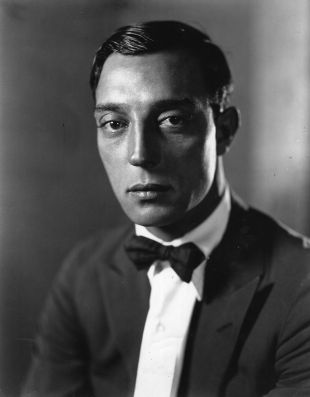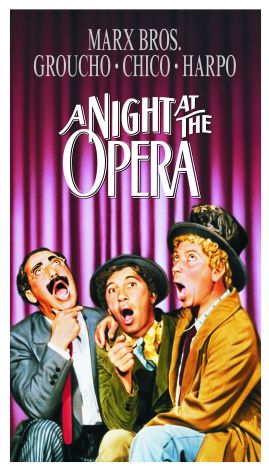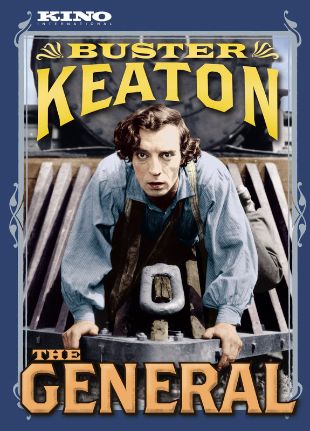Although his career lacked the resilience of Charlie Chaplin and Laurel and Hardy, Buster Keaton may well have been the most gifted comedian to emerge from the cinema's silent era. And while his skills as a gag writer and physical comic were remarkable, Keaton was one clown whose understanding of the film medium was just as great as his talent for taking a pratfall. Keaton, however, had a roller-coaster career in which he fell just as far as he rose, though he was fortunate enough to enjoy a comeback in the later years of his life.
Joseph Frank Keaton was born on October 4, 1895, to Joseph Hallie Keaton and Myra Cutler Keaton, a pair of vaudeville performers. Spending his childhood on the road with his family, he earned the nickname Buster at the age of six months; as legend has it, after the young Keaton fell down a flight of steps at a theater, a magician on the bill, Harry Houdini, said to the lad's father, "What a buster your kid took!" The name stuck, and, by the age of three, the youngster was appearing as part of his parents act whenever they could evade child labor laws. In vaudeville, Keaton developed remarkable talents as an acrobatic comedian with a superb sense of timing, and became a rising star by his teens. His father, however, had developed a serious drinking problem, which strained his relationship with his son and caused serious problems with their very physical stage act, which, in early 1917, Buster left. He appeared in a Broadway comic revue later that year, but the key to Keaton's future came when he met a fellow vaudeville comedian. Roscoe "Fatty" Arbuckle was starring in a low-budget two-reel screen comedy, The Butcher Boy, and invited Keaton to play a small role in the picture. The two hit it off and became a successful onscreen team, starring in a long string of comic hits. Fascinated by the medium of film, Keaton soon began writing their pictures, and assisted in directing them; Keaton was soon starring in his own films, as well, though he and Arbuckle remained lifelong close friends.
Keaton developed a distinctive comic style which merged slapstick with a sophisticated sense of visual absurdity, and often included gags which made the most of the film medium, involving props, sets, and visual trickery that would have been impossible on the vaudeville stage. Keaton also developed his personal visual trademark, an unsmiling deadpan demeanor which made his epic-scale gags even funnier. Beginning with his first solo short subjects in 1920, The High Sign and One Week, Keaton became a major star, and after a series of successful two-reelers, including Cops and The Balloonatic, Keaton moved up to feature-length comedies in 1923 with the farcical The Three Ages. Keaton reached the peak of his craft with the features which followed, including Sherlock Jr., Seven Chances, The Navigator, Steamboat Bill, Jr., and the Civil War comedy The General, now universally regarded as Keaton's masterpiece.
Independent producer Joseph M. Schenck was the man behind Fatty Arbuckle's comedies when Keaton came aboard, and they continued to work together when Keaton struck out on his own. Schenck believed in the comic's talent and allowed him to work without interference, resulting in a string of creative and popular triumphs. Then, in 1928 -- and with Keaton's approval -- Schenck sold his contract to the biggest studio in Hollywood, Metro Goldwyn Mayer. While Keaton's first vehicle for MGM, The Cameraman, was up to his usual high standards, he chafed at the studio's interference and insistence that the filmmaker work within the same boundaries as its other employees. With outside writers and directors controlling Keaton with a strong hand, his work suffered tremendously. Coupled with a crumbling marriage (to Natalie Talmadge, whom he wed in 1920), Keaton began to drink heavily. With the advent of sound, MGM seemed to have even less of an idea of what to do with the actor/director, and starred him in a series of second-rate comedies with Jimmy Durante, whose broad style did not mesh well with Keaton. By 1934, Keaton had hit bottom -- MGM fired him, declaring him unreliable after he refused to work on scripts he felt were inferior. His marriage to Talmadge had ended, and he impulsively (and while drunk) married Mae Scriven, a union that would last only three years. The IRS sued him for 28,000 dollars in back taxes. And his alcoholism had become so destructive that he was committed to a sanitarium, where he was placed in a straight jacket.
Keaton eventually got his drinking problem under control, but his career in Hollywood was in dire straits. He starred in a series of low-budget short subjects for the tiny Educational Pictures and later Columbia Pictures, none of which made much of an impression. Keaton also appeared on-stage in touring productions of such comedies as The Gorilla, and, ironically, found himself employed as a gag writer and director at MGM, albeit at a fraction of his former salary. He also appeared in a few European comedies, where audiences held him in greater regard than in the U.S. But that began to change in 1949, when a cover story in Life magazine on great clowns of the silent movies reminded audiences of his comic legacy. Keaton began making guest appearances on television shows, and the now sober star made his way back into supporting roles in major movies (most notably Around the World in 80 Days and Charlie Chaplin's Limelight). In 1957, Keaton sold the rights to his life story to Paramount Pictures, who hired him as a technical advisor for The Buster Keaton Story. While the film was a severe disappointment (and had little to do with the facts of his life), the financial windfall was enough for Keaton to buy a new house, where he and his third wife, Eleanor Norris (whom Keaton wed in 1940), lived for the rest of their lives. Keaton found himself in increasing demand in the '60s, appearing in several of American International Pictures' "Beach" musicals (in which he was allowed to work up his own gags) and a number of television ad campaigns. He also starred in a short film created by playwright Samuel Beckett, appearing in a loving tribute to his silent films, The Railrodder, and landed a memorable role in A Funny Thing Happened on the Way to the Forum. Sadly, Keaton's second wave of success came to an end on February 1, 1966, when he lost a lengthy battle with lung cancer.



